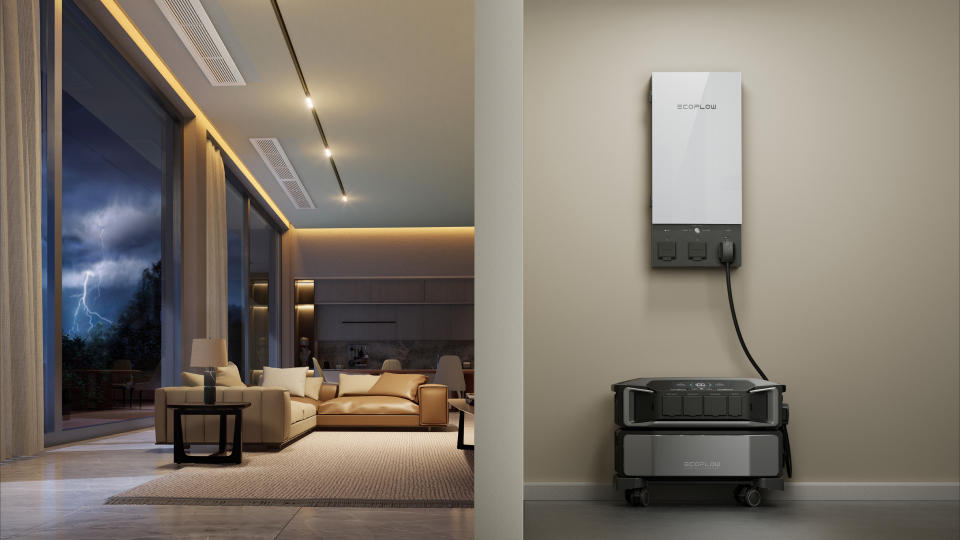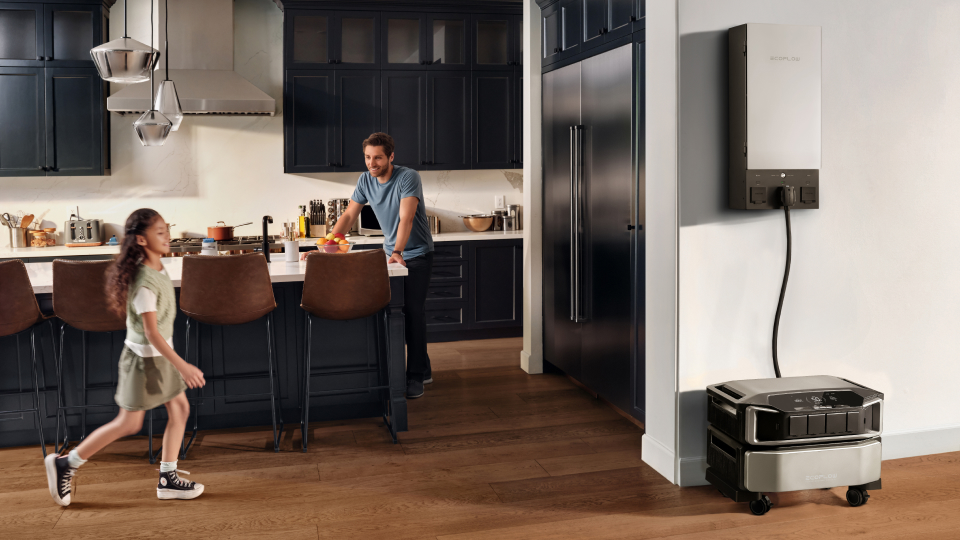- 120V vs. 240V: Your Home's Power Explained
- Common Appliances That Use 240V Power
- Why Many Home Battery Systems Fail to Handle 240V
- How to Choose a 240V-Ready Home Battery System
- A Home Battery System for Uncompromising Power
- The Power of True Whole-Home Independence
- Frequently Asked Questions Of Home Battery Systems
Best Home Battery for 240V Appliances
- 120V vs. 240V: Your Home's Power Explained
- Common Appliances That Use 240V Power
- Why Many Home Battery Systems Fail to Handle 240V
- How to Choose a 240V-Ready Home Battery System
- A Home Battery System for Uncompromising Power
- The Power of True Whole-Home Independence
- Frequently Asked Questions Of Home Battery Systems
A summer heatwave rolls in, and just as the temperature peaks, the power grid fails. You have a home battery, so you're not worried—until you realize it can't run your central air conditioner. Suddenly, your high-tech backup solution can't power the one thing you need most. This is a common reality for those who overlook a crucial detail in their home's energy needs: 240V power.
Choosing the right home battery system is about maintaining your comfort, safety, and modern way of life.
120V vs. 240V: Your Home's Power Explained
First, it is helpful to know the two types of power flowing through your walls. Your home’s electrical system can be compared to plumbing: voltage is the water pressure.
120 Volts (120V): This is your standard "garden hose." It’s perfect for most everyday things, like your lights, TV, refrigerator, and computer. Most outlets in your home deliver 120V power.
240 Volts (240V): This is the "fire hose." It delivers double the electrical pressure and is reserved for your most power-hungry appliances that need a lot more energy to do their jobs.
Virtually every home in the USA uses split-phase electricity, which gives you access to both 120V and 240V circuits to power a wide range of devices and appliances.
Common Appliances That Use 240V Power
What are these power-hungry appliances? You might be surprised by how many of your home's most critical systems run on 240V. These often include:
| Appliance/Equipment | Why You Need 240V |
| Central AC & Heat Pumps | Essential for comfort and safety in extreme weather |
| Electric Dryers | 120V can't generate enough heat for efficient drying |
| Electric Stoves & Ovens | Required to cook meals during outages |
| Electric Water Heaters | Needed to maintain hot water supply |
| Level 2 EV Chargers | Level 1 (120V) takes days; 240V is a must for EV owners |
| Well Pumps | Critical for water supply in homes with well water |
| Heavy Workshop Tools | Welders, table saws, and compressors require 240V |
Losing power to these appliances is a major disruption. That is why ensuring your backup power solution can handle them is so important.
Why Many Home Battery Systems Fail to Handle 240V
Not all home battery systems are created equal. Many are designed primarily to power 120V circuits, and they fall short when faced with the demands of a modern, all-electric home.
Power Output vs. Surge Demand: The A/C Test
There are two key metrics to know:
Continuous Power (kW): This is the amount of power a battery can supply consistently over time. It’s like a marathon runner's steady pace.
Surge Power (or Peak Power): This is the brief, massive burst of power a battery can supply to start up an appliance with a motor. It’s a sprinter's explosive start.
Your central air conditioner is the ultimate test. When its compressor kicks on, it requires an enormous surge of power for just a second or two—a demand known as Locked Rotor Amps (LRA). Many battery systems lack the surge capacity to meet this initial demand, so the A/C will fail to start, even if the battery could technically run it once it's going.
The Pitfalls of "Partial" Backup Solutions
To get around these limitations, some companies offer "partial" backup solutions. This often involves installing a separate sub-panel and moving only a few "critical" 120V circuits (like the refrigerator and some lights) to be powered by the battery.
This approach has major drawbacks:
It’s a Compromise: You’re forced to choose what to live without during an outage. No A/C in the summer, no hot meals from your electric stove, and no clean laundry.
It Can Be Costly and Complex: Installing a sub-panel requires significant electrical work, adding to the overall cost and installation time.
It’s Not a True Whole-Home Solution: You're left with a system that can’t support your modern lifestyle when you need it most. A true whole home battery should power your entire home without compromise.


How to Choose a 240V-Ready Home Battery System
To ensure your investment provides true energy security, you need a system built to handle your entire home's needs. Here are the non-negotiable features to look for in a 240V-ready home battery system.
4 Key Specifications of True Whole-Home Backup Systems
✅ Native Split-Phase 240V Output: This is the most important feature. The system must be able to output 120V and 240V power simultaneously from a single inverter. Without this, it simply cannot run your large appliances.
✅ High Continuous Power Output: Look for a system that can deliver at least 7kW of continuous power, with higher outputs like 10-12kW being ideal for running multiple large appliances at once.
✅ High Surge Capacity: The system must have a robust surge rating to handle the LRA of large motors, especially your A/C unit or well pump.
✅ Expandable Battery Capacity (kWh): Power (kW) and energy capacity (kWh) are different. Capacity determines how long you can run your appliances. A modular system that allows you to add more battery packs gives you the flexibility to prepare for short-term or week-long outages.
✅ Seamless Home Integration: The best systems integrate directly with your main electrical panel via an automatic transfer switch or smart panel. This allows for an instantaneous and automatic transition to battery power the moment the grid goes down—so seamless you won't even notice it happened.
A Home Battery System for Uncompromising Power
Finding a system that checks all these boxes can seem daunting, but solutions designed for complete energy independence are available. Instead of compromising, you can have a system that powers your entire home, just as if the grid were still on.
EcoFlow DELTA Pro Ultra X: Powering 100% of Your Home
The EcoFlow DELTA Pro Ultra X was engineered specifically to solve the challenges of powering a modern American home. It is a powerful and flexible home battery system designed for users who refuse to compromise on comfort and convenience.
A single DELTA Pro Ultra X inverter delivers a massive 12kW of continuous 120V/240V split-phase output. This is more than enough power to run multiple heavy-duty appliances at the same time. Its intelligent design can handle immense power surges, allowing it to effortlessly start and run even a 5-ton central air conditioner—a task that is impossible for many competing systems.
Furthermore, its energy capacity is fully modular. You can start with the standard 12kWh configuration (2 battery packs) and expand up to 60kWh per inverter or 180kWh for the full system, ensuring your family stays safe and comfortable through any outage. Paired with the EcoFlow Smart Home Panel 3, it integrates seamlessly into your home for automatic, whole-home backup and intelligent energy management, giving you ultimate control and peace of mind.
The Power of True Whole-Home Independence
With backup power, do not let 240V appliances be your blind spot. Knowing your home's full energy needs is the first step toward choosing a system that won't let you down. A partial backup is a partial solution, but a powerful, 240V-native home battery system is your ticket to true energy independence. With the right technology, you can keep your lights on, your A/C running, and your life uninterrupted, no matter what happens on the grid.


Frequently Asked Questions Of Home Battery Systems
Q1. Can a home battery system increase my property value?
Yes, a professionally installed whole home battery can be a significant selling point and potentially increase your property value. It offers prospective buyers energy security, resilience against power outages, and the potential for lower electricity bills, especially if paired with solar panels. It is a major home upgrade, similar to a new roof or a renovated kitchen, that provides tangible benefits and modern appeal.
Q2. How long does a home battery system last?
The lifespan of a home battery system is typically measured in charge cycles and years. Most modern systems, like those from EcoFlow, use Lithium Iron Phosphate (LFP or LiFePO₄) battery chemistry. LFP batteries are known for their safety and longevity, often lasting for 3,500-6,000 full charge/discharge cycles. For a typical household, this translates to a lifespan of 10 to 15 years or more before the battery's capacity begins to noticeably degrade.
Q3. Do I need solar panels to use a home battery system?
No, you don't necessarily need solar panels. A home battery system can be charged directly from the electrical grid. This is useful for storing energy during off-peak hours when electricity rates are cheaper and then using that stored energy during peak hours to save money. Pairing your battery with solar panels is the best way to achieve true energy independence, protect yourself from rising electricity costs, and power your home with clean, renewable energy.
Q4. What's the difference between AC-coupled and DC-coupled battery systems?
The difference is how the battery connects to your solar panel system.
DC-coupled: The solar panels (which produce DC power) connect directly to the battery through a charge controller. The stored DC power is then converted to AC power by a single inverter to power your home. This is generally more efficient.
AC-coupled: The DC power from solar panels is first converted to AC by a solar inverter. To charge the battery, that AC power must be converted back to DC. To power your home from the battery, it's converted to AC again. This is great for adding a battery to an existing solar setup.